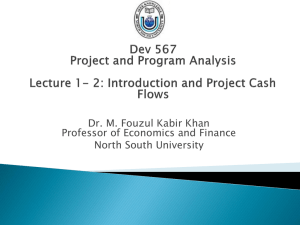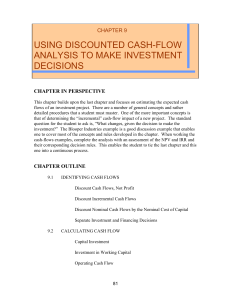Review of Incremental Cash Flow Analysis
advertisement
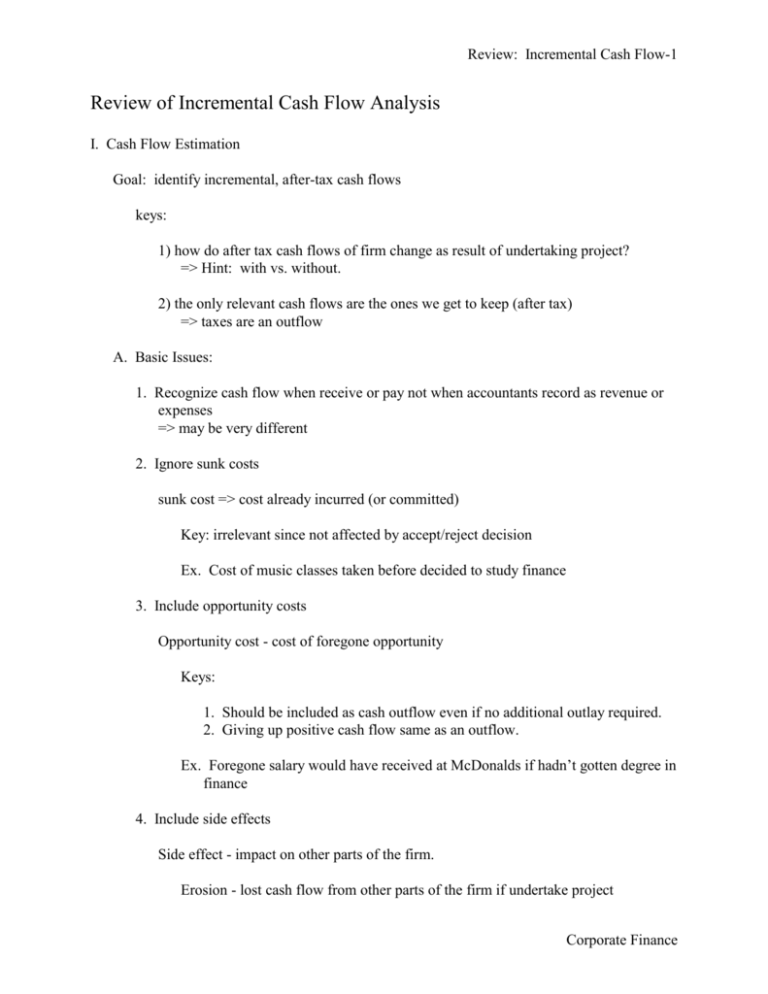
Review: Incremental Cash Flow-1 Review of Incremental Cash Flow Analysis I. Cash Flow Estimation Goal: identify incremental, after-tax cash flows keys: 1) how do after tax cash flows of firm change as result of undertaking project? => Hint: with vs. without. 2) the only relevant cash flows are the ones we get to keep (after tax) => taxes are an outflow A. Basic Issues: 1. Recognize cash flow when receive or pay not when accountants record as revenue or expenses => may be very different 2. Ignore sunk costs sunk cost => cost already incurred (or committed) Key: irrelevant since not affected by accept/reject decision Ex. Cost of music classes taken before decided to study finance 3. Include opportunity costs Opportunity cost - cost of foregone opportunity Keys: 1. Should be included as cash outflow even if no additional outlay required. 2. Giving up positive cash flow same as an outflow. Ex. Foregone salary would have received at McDonalds if hadn’t gotten degree in finance 4. Include side effects Side effect - impact on other parts of the firm. Erosion - lost cash flow from other parts of the firm if undertake project Corporate Finance Review: Incremental Cash Flow-2 Key => impacts on other parts of the firm that results from the project should be included as cost/benefit of project Ex. Less time for playing compuer games since studying all the time for finance classes 5. Don't allocate overhead. Overhead => fixed cost key => assign all of any change in fixed costs to the project, none of existing costs. Ex. Rent on apartment 6. Include changes in net working capital Net working capital => CA - CL keys: 1. investment in inventory ( and other CA) requires cash outflow just like building construction does. 2. Recovery at end of project's life provides positive cash flow Ex. Supply of diskettes, pencils, paper, etc.; credit card balance 7. Depreciation Note: source of one of biggest differences between cash flow and accounting income. a. Impact of depreciation 1) depreciation's only importance is due to tax consequences => not a cash flow itself 2) reduces taxable income => reduces taxes => increases CF => reduction in taxes = depreciation tax rate. 3) depreciation methods used in this class. a) Straight line => depreciation = C - SV N Corporate Finance Review: Incremental Cash Flow-3 where: C = cost SV = salvage value N = life of asset (in years) b) Depreciation under the 1986 Tax Reform Act -allows for faster depreciation => receive positive CF from depreciation tax shield faster => increases NPV of investments. Note: instituted by Congress to stimulate investment. Depr = DB D% where: Depr = depreciation DB = depreciable basis D% = depreciation percentage Depreciation Percentages under 1986 Tax Act (MACRS) Year 1 2 3 4 5 6 7 8 3-yr class 33.34% 44.44 14.81 7.41 5-yr class 20.00% 32.00 19.20 11.52 11.52 5.76 7-yr class 14.28% 24.49 17.49 12.50 8.92 8.92 8.92 4.48 DB = PP + Tr + Inst where: PP = purchase price Tr = transportation Inst = installation Corporate Finance Review: Incremental Cash Flow-4 Note: Salvage value doesn't affect. D% => see depreciation table in textbook (or formula sheet) b. Example Purchase new machine for $95,000. Installation and shipping = $5000 Life of machine is 6 years Expected salvage value at end of 6 years = $10,000 Falls in 3 year depreciation class Tax rate = 40% Straight Line = 100,000 - 10,000 = 15,000 per year 6 => impact of cash flow = 15,000 .4 = +6000 per year 1986 tax act: Year Depreciation Cash flow All D.B. D% Depr. Tx Yr 1 Yr 2 Yr 3 Yr 4 33,340 44,440 14,810 7,410 +13,336 +17,776 +5924 +2964 c. Discounting depreciation key => often treated as a risk-free cash flow => discount at risk-free rate 8. Treat inflation consistently a. Key => discount real cash flows with a real interest rate and nominal cash flow with a nominal interest rate => get same answer either way as long as consistent b. Ex. Assume planning to build a new memory chip factory at a cost of $5 billion. Sales are expected to be 45 million chips per year for 2 years (beginning one year from today). The current sales price for chips is $125 each and is expected to increase by 9% per year for the next 2 years. The cost per chip is $70 and is Corporate Finance Review: Incremental Cash Flow-5 expected to increase by 2% per year. Overall inflation is 6% per year and the nominal required return is 11% CF0 (in millions) nominal: -5,000 real: -5,000 CF1 nominal: 45 125 1.09 45 70 1.02 2918.25 2918.25 2753.07 real: 1.06 CF2 nominal: 45 125 1.09 45 70 1.02 3405.80 3405.80 3031.15 real: 1.06 2 2 rreal 2 .11.06 .04717 1.06 NPV nom 5000 2918.25 3405.80 393.28 1.11 1.11 2 NPV real 5000 2753.07 3031.15 393.28 1.04717 1.04717 2 B. Basic Approaches to Coming up w/ Cash Flows 1. CF = R - C - Tx where: R = cash revenues C = cash costs Tx = taxes = (R - C - Depr) Tc Depr = depreciation expense Tc = marginal tax rate for firm 2. CF = R (1 - Tc) - C (1 - Tc) + Depr Tc Corporate Finance Review: Incremental Cash Flow-6 Notes: 1) Use whichever easier since can show that mathematically equivalent 2) If discount depreciation at risk-free rate and other cash flows at risk-adjusted rate, need to use 2nd approach II. Example Wal-Mart is considering building a new Sam's Wholesale Club in West Waco. Given information below, examine cash flows used in NPV analysis for years 0, 1, 2, and 30 (when store closes). Assume Wal-Mart's tax rate is 40%. 1. Store will cost $20M (20 million) to build and will fall in the 7 year depreciation class. Expected salvage value of building in 30 years is $1.5M. CF0 = -$20M CF1 = 20M (.1428)(.4) = +$1,142,400 CF2 = 20M(.2449)(.4) = +$1,959,200 CF30 = 1.5M - 1.5M(.4) = +$900,000 2. Market analysis done last year cost $25,000. Payable today. => CF0 = sunk => irrelevant => don't include in NPV calculation 3. Land on which will build bought 2 years ago for $200,000. Could sell today for $180,000. If build the store, estimate that land can be sold in 30 years for $450,000. => opportunity cost of using land should be included in NPV Cash flow if sell today = 180,000 - (180,000 - 200,000)(.4) = $188,000 => CF0 = -$188,000 Cash flow if sell in 30 years = 450,000 - (450,000 - 200,000)(.4) = $350,000 => CF30 = +350,000 4. Contracted to clear land for $50,000. Amount already paid. Clearing begins today. If cancel contract, get back all but $10,000 non-refundable portion. => CF0 = -$40,000 - (- $40,000) .4 = -$24,000 5. Net working capital balances given as follows: Year NWC Corporate Finance Review: Incremental Cash Flow-7 0 1 2 29 30 $2.0M $2.2M $2.3M $11.0M $0.0M CF0 = -$2M CF1 = -$200,000 CF2 = -$100,000 CF30 = + $11M 6. Sales and cost of sales at Sam's are as given below. Cost of sales includes cost of goods sold, labor costs, utility costs, etc. Some of the sales from the new Sam's would have occurred at the Waco’s existing Sam’s and Wal-Marts. These figures have also been estimated and given below: Sam's Wholesale Club Year Sales Cost of Sales 1 20.0M 21.0M 2 40.0M 37.0M 30 200.0M 170.0M Lost sales at existing stores Sales Cost of Sales 5.0M 4.0M 8.0M 6.4M 40.0M 32.0M CF1 = (20M - 5M) - (21M - 4M) - (-2M)(.4) = -$1,200,000 CF2 = (40M - 8M) - (37M - 6.4M) - 1.4M(.4) = $840,000 CF30 = (200M - 40M) - (170M - 32M) - 22M(.4) = $13,200,000 7. Administrative costs at home office in Arkansas will increase from $100,000,000 to $100,002,000 next year. Administrative costs are expected to rise by 7% per year over the next 30 years. Accountants will assign 0.02985% of the total administrative costs to the new Sam's. CF1 = -2000 - (-2000)(.4) = -$1200 CF2 = -1200(1.07) = -$1284 CF30 = -1200(1.07)29 = -$8539 8. Putting it all together CF0 = -20,000,000 - 188,000 -24,000 - 2,000,000 = -$22,212,000 CF1 = 1,142,400 - 200,000 - 1,200,000 - 1200 = -$258,800 CF2 = 1,959,200 - 100,000 + 840,000 - 1284 = $2,697,916 CF30 = 900,000 + 350,000 + 11,000,000 + 13,200,000 - 8539 = $25,441,461 NPV => PV of all CF Corporate Finance Review: Incremental Cash Flow-8 Corporate Finance

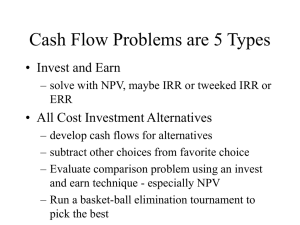

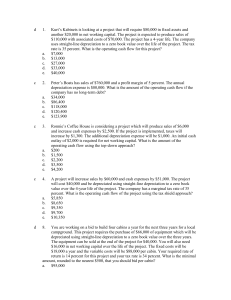
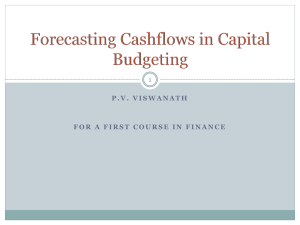
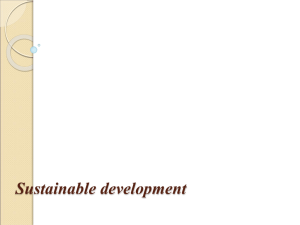
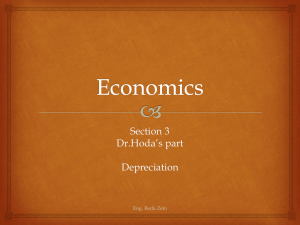
![Quiz chpt 10 11 Fall 2009[1]](http://s3.studylib.net/store/data/005849483_1-1498b7684848d5ceeaf2be2a433c27bf-300x300.png)
